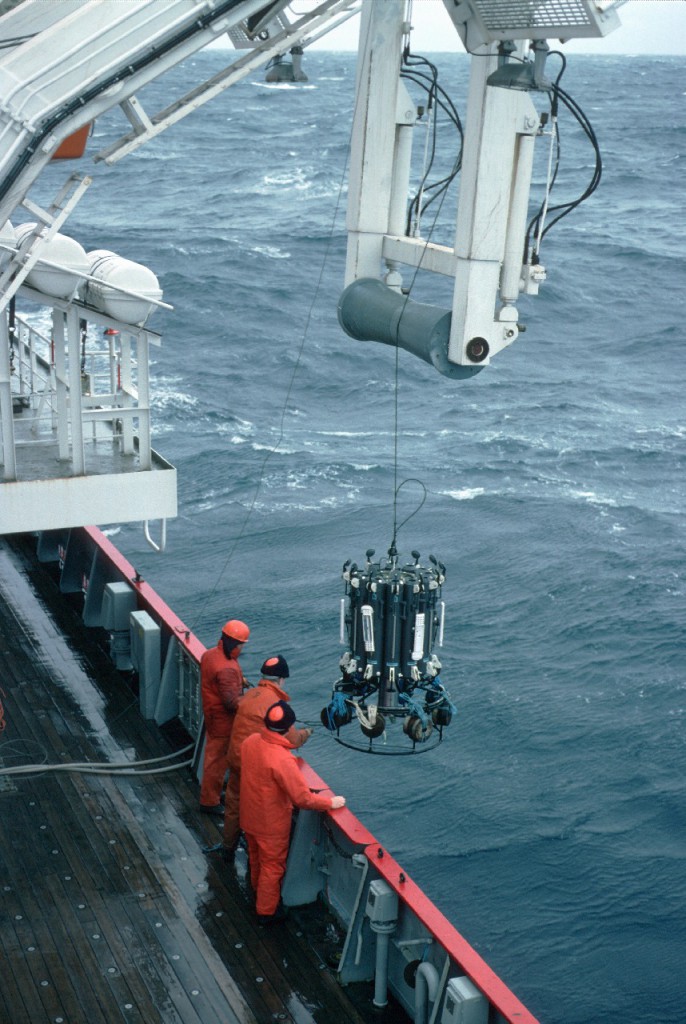Ocean Chemistry on the JCR – March 21st 2012
23 March, 2012 RRS James Clark Ross
Douglas Hamilton, University of East Anglia
Water chemistry is employed during cruises to look for various things of interest to Oceanographers like temperature, salinity, dissolved oxygen and chlorophyll.
Temperature and salinity can be used to tell us something about where the water comes from, for example warmer water originates from the hotter equator and colder water from the poles. Salinity is a measure of how “salty” the water is; new fresh water from ice melting for example lowers this, whereas evaporating water at the tropics raises this value. Salty water is of particular interest in understanding global ocean movements as it is heavier than fresh water and sinks, helping to create an ocean transport system around the world.
Dissolved oxygen and chlorophyll can be used as a measure of how biologically productive an area is. Levels of chlorophyll are related to microscopic phytoplankton (tiny plants) that live near the surface of the ocean.
Phytoplankton create their own food much the same as their larger relatives on the land, using photosynthesis to harvest the power of the sun to create sugars. Chlorophyll levels are of interest to researchers in many fields, both biological and chemical. In areas of upwelling, where water is brought up from the depths of the ocean, it carries with it essential nutrients for the phytoplankton to grow. A high chlorophyll count can help show where these nutrient upwelling regions are, or alternatively where nutrients from the atmosphere are entering through the surface of the ocean. As photosynthesis uses up carbon dioxide, the phytoplankton could help in a small way to lowering global warming if there is enough of them in the right area. Polar regions have some the highest chlorophyll levels in the world, helping to provide a strong start to the food chain and feed the large range of life living below the surface. Oxygen in the oceans is an essential part of animal life in the seas as much as on land, low levels can be potentially dangerous to many species. It is important for the safe future of all Oceans that we keep recording all these things and further develop our understanding of how these great blue oceans work.
The water to be analysed is collected using a piece of apparatus called a “CTD” which is lowered on a steel wire to the ocean depths. This consists of thick grey plastic tubes called Niskins that are mounted on a steel frame called a Rosette. A maximum of 24 Niskins can be “fired” at any given depth from a chosen location. Each Niskin collects the sample of the water traversing through it by snapping shut two water tight bungs at either end. It is common practice to collect the water as the Rosette is ascending to the surface, this is because areas of interest spotted on the descent can be the ones captured. This water is then analysed onboard the ship using different techniques. Oxygen is measured by titration using the Winkler method which traps all the oxygen in the water. Chlorophyll is measured by filtering the water through filter paper and measuring the green bits in leftover cells with a fluorometer. Salinity is tested with a clever instrument that measures all the various salts within the water.

Position Report for Entry
| Latitude: | 52° 19′ S |
| Longitude: | 57° 12′ W |
| Cruise Number: | (not entered) |
| Heading: | 286.37° |
| Wind: | |
| Air Temperature: | 3.1°C |
| Sea Temperature: | 6.7°C |
| Pressure: | 993.31 hPa |